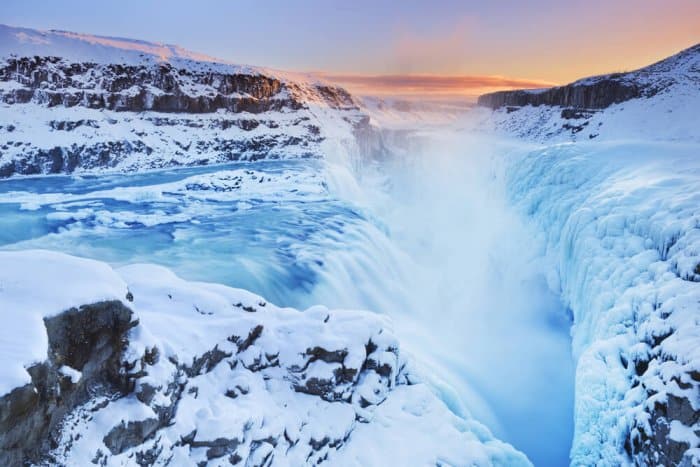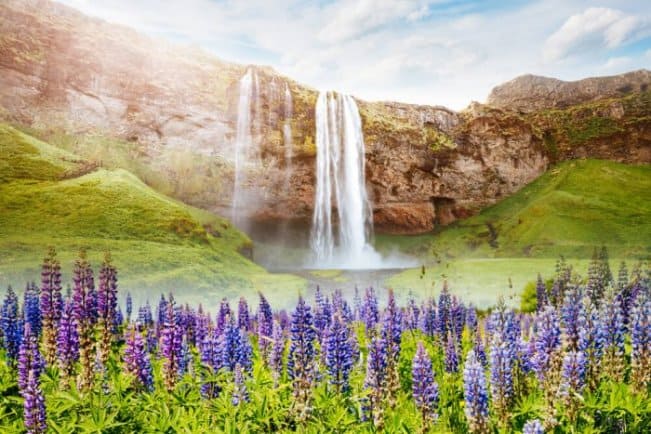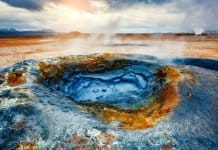When planning a vacation to Iceland, there are certain things to keep in mind. The weather during each month will directly affect what you will pack. The average monthly temperature in Iceland is another consideration. And because Iceland is so far north, the number of daylight hours you will experience during your trip varies widely depending on what time of year you visit. Let’s take a look at the average number of daylight hours, the weather and the temperature in Iceland throughout the year.

Iceland’s proximity to the North Pole means it can get quite cold here. And temperatures in the summer or not going to be nearly as hot as those in countries closer to the Equator. So while other places might be experiencing a heatwave, Iceland weather in June, July and August will be much cooler. Its northern latitude also provides nearly unending daylight during the summer months. By contrast, the amount of hours of sunshine in Iceland in the winter is significantly reduced. This directly affects the activities that you can do in Iceland because the Northern Lights are not visible in the summer, but you have plenty of extra time for hiking and outdoor pursuits. Let’s look at a weather and temperature breakdown for Iceland on a month-by-month basis.
Iceland’s Weather in January
This month is smack dab in the middle of winter, which makes it one of the coldest, darkest months in Iceland. Colder temperatures mean that certain activities like exploring ice caves and hiking on glaciers are now on your Iceland travel menu.
Average temperature: The average monthly high is 1.9 °C (35.4 °F). The average monthly low is -3 °C (26.6 °F).
Hours of Daylight: The sun typically rises around 11 am and sets shortly after 4 pm in January, providing around five hours of sun. It moves closer to six hours toward the end of the month.
Typical Weather: As they say in Iceland, if you don’t like the weather, just wait five minutes and it will change! Because temperatures are hovering close to freezing much of the time, you are very likely to see lots of ice and snow, so please dress accordingly! It’s not all bad news though. There are days with clear blue skies, so it’s not totally gloomy. So bring your sunscreen and be prepared for anything.
Iceland’s Weather in February
February is still at the height of the Icelandic winter, so it’s very similar to January. Favorite activities include going to the Northern Lights as well as skiing. The area around Akureyri and Dalvík is the skiing and snowboarding capital of Iceland, so head there if you’d like to hit the slopes.
Average temperature: The average monthly high is 2.8 °C (37 °F). The average monthly low is -2.1 °C (28.2 °F).
Hours of Daylight: By February, the sun has started to come out more. It usually rises around 9:30 am and sets around 6 pm, for a total of approximately nine hours of sunlight per day.
Typical Weather: February is quite cold and you can experience overcast skies or sunny days.

Iceland’s Weather in March
Temperatures in Iceland are still pretty cold, but the good news is that you really start getting more hours of daylight. We are slowly heading into summer now and the small Nordic country begins to show that it’s located close to the North Pole.
Average temperature: The average monthly high is 3.2 °C (37.8 °F). The average monthly low is -2 °C (28.4 °F).
Hours of Daylight: The sun is up by 8 am and doesn’t go down until shortly before 8 pm in March. We’ve added about two hours of daylight this month with things increasing steadily through the 31st. Expect 11-12 hours of sunshine in Iceland in March.
Typical Weather: It’s still pretty cold, so make sure you bundle up. You may also experience a little bit of rain, so as we’ve mentioned before, pack well! Iceland can be quite wet and you don’t want the dampness to seep into your clothing.
Iceland’s Weather in April
We’ve finally turned a corner! Well, sort of. Iceland has finally left the freezing temperatures of winter behind (but not by much, unfortunately). Every little bit helps though, right? We’ve got more daylight hours and that has to count for something.
Average temperature: The average monthly high is 5.7 °C (42.3 °F). The average monthly low is 0.4 °C (32.7 °F).
Hours of Daylight: Depending on the time of the month, the sun rises around 6 am and doesn’t go down until after 8 pm. These hours are probably closer to what you are used to in your home country.
Typical Weather: You’re probably going to start noticing a theme here: layer, dress warmly and be prepared for anything. You might be facing a snowstorm or hailstorm one day. The next day you could have clear blue skies. Or both could happen on the same day, especially during these “in between”months.
Iceland’s Weather in May
Things are heating up fast, at least by Icelandic standards. We’ve almost reached summer and it shows with both the weather and temperature as well as daylight hours. While the puffins and whales have not quite returned yet (sorry animal lovers), May tends to be a very sunny month and less windy and icy than previous months. It’s definitely much nicer to be outside during May in Iceland.
Average temperature: The average monthly high is 9.4 °C (48.9 °F). The average monthly low is 3.6 °C (38.5 °F).
Hours of Daylight: Things start to get really interesting now, with there being 18-20 hours of daylight. The sun can rise as early as 3:30 am or as late as 5 am. It sets between 10 pm and 11:30 pm.
Typical Weather: As I mentioned, May is sunnier and less windy than previous months but that doesn’t mean that it’s a complete walk in the park. Come prepared for everything.

Iceland’s Weather in June
Summer is finally here! The country really alive with outdoor festivals. Flowers begin to bloom and you can see those lush, green landscapes from travel brochures. Be sure to bring your camera!
Average temperature: The average monthly high is 11.7 °C (53.1 °F). The average monthly low is 6.7 °C (44.1 °F).
Hours of Daylight: Iceland truly becomes the Land of the Midnight Sun during June. With sunset just after midnight and sunrise around 3 am, it could be difficult to get some shut-eye. Make sure you pack your eye mask if you travel to Iceland during June.
Typical Weather: June is a pretty safe bet as far as weather is concerned in Iceland but there are always exceptions. This year has been particularly cold and rainy and some years there are even been snowstorms in June! It’s not as likely as in the winter but it has been known to happen.
Iceland’s Weather in July
July is one of the most popular times to visit Iceland. Its higher temperatures make it ideal for experiencing outdoor activities like hiking in Landmannalaugar. You can see Iceland in all of its splendor during the month of July.
Average temperature: The average monthly high is 13.3 °C (55.9 °F). The average monthly low is 8.3 °C (46.9 °F).
Hours of Daylight: The Midnight Sun continues in July with 18-20 average hours of daylight. The sun rises between 3 am and 4:30 am and sets between 10:30 pm and midnight.
Typical Weather: July is the warmest month in Iceland on average, so take advantage of all of those extra daylight hours and get outside! Remember to dress in layers, even in summer, because while temperatures are warm, they are not what’s traditionally considered “hot”.
Iceland’s Weather in August
While the weather is still pretty good in Iceland in August and temperatures are still relatively high, the Midnight Sun has started to wane a little.
Average temperature: The average monthly high is 13 °C (55.4 °F). The average monthly low is 7.9 °C (46.2 °F).
Hours of Daylight: The month of August has fewer daylight hours than previous months. There are about 15-18 hours of daylight with the sun coming up as early as 4:30 am or as late as 6 am and setting between 8:45 pm and 10:30 pm.
Typical Weather: August is still a wonderful time of year to visit Iceland. You’ve got the nicer weather and sunny days similar to June and July and still have pretty high temperatures.
Iceland’s Weather in September
Tourist season starts to wind down a little in September. From the middle of the month onward, you can begin to see the Northern Lights, and temperatures drop a bit as they begin their autumn descent back to the colder months of winter. It hasn’t gotten too cold yet, and September is the perfect month to visit Iceland if you are looking to combine fair weather with viewing the Aurora Borealis. It is a great time to go camping in Iceland or do a road trip on the island.
Average temperature: The average monthly high is 10 °C (50.2 °F). The average monthly low is 5 °C (41 °F).
Hours of Daylight: You’ll start having relatively normal daylight hours again in Iceland in September. The sun rises between 6 am and 7:30 am and sets between 7 pm and 9 pm for a total of 11.5 – 14.5 hours daily.
Typical Weather: Things have started to cool off in September but you’ve still got nice weather and relatively good temperatures.

Iceland’s Weather in October
You can definitely notice a drop in the temperature and a change in the weather in Iceland in October. It’s still a good time to visit and things have not gotten quite so extreme as they are in winter.
Average temperature: The average monthly high is 6.8 °C (44.2 °F). The average monthly low is 2.2 °C (36 °F).
Hours of Daylight: October in Iceland means fewer daylight hours. The average can be as much as eleven or as little as eight. The sun rises between 7:30 am and 9 am and sets between 5 pm and 7 pm.
Typical Weather: October weather in Iceland is definitely closer to winter weather as we know it in many parts of the world. Be sure to pack a good rain jacket and be prepared for rain and wind.
Iceland’s Weather in November
November is the second to last month of the year and you can definitely tell that winter is right around the corner. Low temperatures have dipped back below freezing and there are significantly fewer daylight hours.
Average temperature: The average monthly high is 3.4 °C (38.1 °F). The average monthly low is -1.3 °C (29.7 °F).
Hours of Daylight: You’ll start to notice a big difference in Iceland in November because we only have 5-8 hours of sunlight. Sunrise is between 9 am and 10:45 am and dusk falls between 3:45 pm and 5 pm. Time to head inside and prepare something warm to drink or maybe even explore Reykjavik’s bar scene.
Typical Weather: While we’re not officially in winter yet, it can sure feel like that in Iceland during the month of November. Be prepared for lots of ice and snow. The days that it doesn’t snow tend to be overcast and cloudy, and you may experience light rain and even fog while you are driving.
Iceland’s Weather in December
We’ve arrived at winter. The country is cold, icy, and covered with snow. That being said, it’s not too cold. Cities in Iceland like Reykjavik experience winters that can best be compared to places like New York. Yes, it is around 0°C (32 °F) but it’s not as frigid as you would expect for a country so far north. Places like Chicago, for example, get month colder during the winter months.
Average temperature: The average monthly high is 2.2 °C (36 °F). The average monthly low is -2.8 °C (27 °F).
Hours of Daylight: Just as we had the Midnight Sun at the peak of summer, in winter the opposite is true. With just 4-5 hours of sunlight, this can be a bleak time. Luckily we have Christmas to cheer us up! The sun rises around 11 am and sets around 3:30 pm.
Typical Weather: It’s cold, icy and wet, just like November. If you plan on driving in Iceland during this time, be sure to give yourself plenty of extra time for snowstorms, hailstorms, fog, and any other natural elements that might slow down your travels. And of course, always proceed with caution. If you get caught in a storm, wait until it passes. It’s always better to be safe than sorry.
Iceland’s Weather During the Year with Temperature and Daylight Hours
If you’d like to check the daylight hours during dates for your trip to Iceland, visit timeanddate.com. You can also check the weather forecast at the Icelandic Meteorological Office’s official website. Whatever time of year you decide is the best time to go, we know you’ll have an unforgettable trip to Iceland!





























